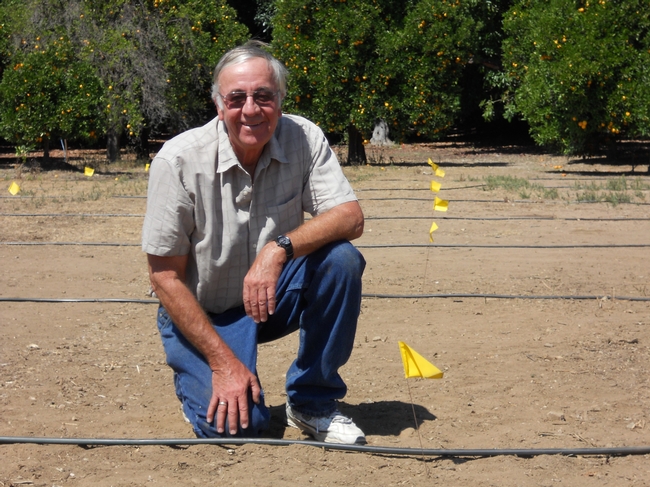After a 30-year career as the farm advisor of subtropical fruit crops in San Diego County, I've decided to retire to do some other things, including some fishing. According to my wife, that seems to mean some painting, re-tiling the floor, re-landscaping and cabinet work. I'm not sure we are speaking the same language!
First, I'd like to thank all of the really great growers in this county. When I first started I knew a lot about dry root rot of citrus (since that was my research topic in college) and quite a bit about avocado root rot. And I had a pretty good background in diseases and other problems that bother plants. But not much else! I learned a lot about irrigation, frost protection, gopher control etc. from growers and the extension specialists. I even learned how to turn on wind machines and light orchard heaters at 3:00 am from grower John Hankey in Pauma Valley.
Prior to being a farm advisor, I spent four years in grad school at UC Riverside under Dr. John Menge. And he was a great mentor. He understood how important field research was for growers to be successful and he encouraged me to go into extension work.
Prior to getting my Ph.D. in plant pathology I worked one year for the Riverside County Ag Dept, four years for the Orange County Ag Dept as a plant pathology technician and 3 years as a staff research associate at UC Riverside in Entomology, Nematology and Plant Pathology. Oddly enough, it was the Riverside County job that changed the course of my career. I was a floating “problem solver” that basically diagnosed diseases and other problems for growers and homeowners and I got to drive to the calls in a really fast car turned in by the retired sheriff. And I did such a good job I got a “promotion” to being in charge of all the fruit fly trapping from Indio out to Blythe. And this happened in the summer! That's when I decided it might be in my best interest to go back to grad school under Dr. Menge and work on the cause of a citrus trunk disease.
I have worked on a lot of projects over the years with the professors, specialists and other farm advisors. Just a few highlights from over the years:
Dr. Mary Lu Arpaia and I started an avocado rootstock trial in 1986 that evaluated the yield of some of our new rootstocks in “clean” soil (without Phytophthora cinnamomi root rot). It turned out to be a very important trial because it showed that the G755 series (our most resistant rootstock to root rot) was actually very poor at producing fruit when it was grafted to Hass. From there Dr. Arpaia and I and the other farm advisors all worked on irrigation trials and fertilizer trials in order to establish some basic information on the water and NPK requirements for Hass avocados.
I conducted a reclaimed water trial with the City of Escondido from 1991 to 1996 and the results showed that, because of the high salt content in their reclaimed water, yields were reduced by 40% compared to district water. But that set the stage for a current trial by Dr. David Crowley with the City of Escondido in which reverse osmosis will be used to separate the brine out and have it go out to the ocean in their outfall. The less saline reclaimed water will then be piped to the backside of Escondido to be used for agriculture. I think, with our high water prices that may be the future in our county.
Ben Faber and I conducted avocado pruning trials in the late 90's and early 2000's, which showed mixed results, but taught us some lessons. Pruning should be done early in the year, and not in the summer because that's when fruiting wood is forming for the following spring. These results will be described again in a future article.
At the same time, Ramiro Lobo and I started blueberry variety trials and eventually irrigation trials. This work, along with work by advisors Faber and Mark Gaskell, set the stage for a new crop in California: low chill early season blueberries. Unfortunately, this is definitely not a low water-using crop. In fact, in a Valley Center trial, we got our best yields when we irrigated with 40% more water than avocados (on an acre basis).
For the last five years I have worked on IPM techniques to control the Diaprepes citrus root weevil along coastal San Diego and Orange counties (in conjunction with Jim Bethke, Joe Morse and Loretta Bates). We used a special landscape cloth under the lemon trees to block the adults from emerging from the soil and it also blocked the young weevils that had just hatched on the leaves from entering the soil. Blocking the entrance and exit turned out to be a great IPM technique for controlling this pest. We also imported parasites from Florida and released them, and the parasites established. These releases have apparently slowed down the spread of this invasive pest because we do not see that they are spreading away from the original quarantine zone. Without the parasites, I doubt that our citrus along the coast would be surviving today, based on all of the sick and dying lemon trees we saw at the beginning of this project.
Currently I have a project with the California Avocado Commission which is taking a look at two pruning styles for a high density planting of Hass and Lamb Hass. Connected to this project are classes for new avocado growers. I will continue this project at least for the next three years as an emeritus farm advisor. Why? Because I think high density has the potential to increase yield per acre substantially, and it's just so darn interesting!
Now, I'm going to do some fishing, and a little house painting.
